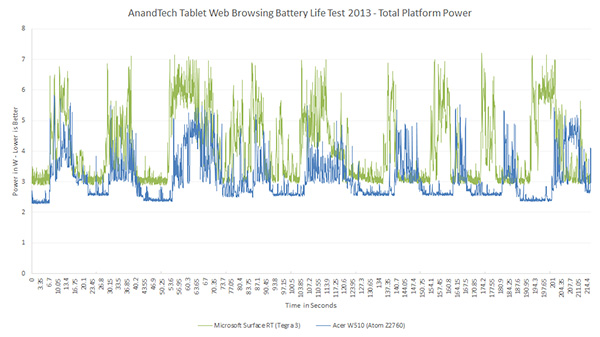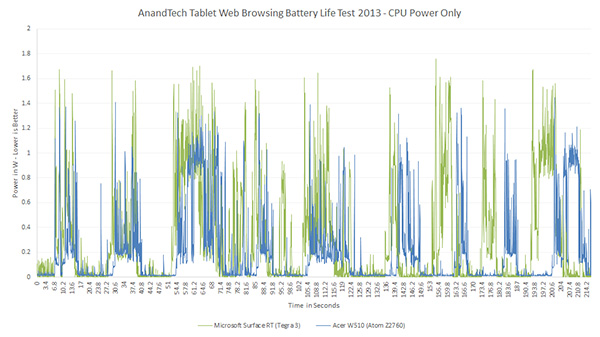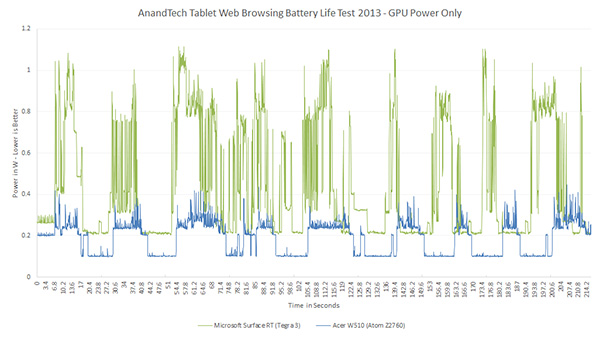The x86 Power Myth Busted: In-Depth Clover Trail Power Analysis
by Anand Lal Shimpi on December 24, 2012 5:00 PM ESTWireless Web Browsing Battery Life Test
For our final test I wanted to provilde a snippet of our 2013 web browsing battery life test to show what its power profile looked like. Remember the point of this test was to simulate periods of increased CPU and network activity, that could correspond to more than just browsing the web but interacting with your device in general.
Those bursts of power consumption are the direct result of our battery life test doing its job. That the tasks should take roughly the same time to complete on both devices, making this a good battery life test by not penalizing a faster SoC with more work.
Note that the W510's curve ends up lagging behind Surface RT's curve a bit by the end of the chart. This is purely because of the W510's garbage WiFi implementation. I understand that a fix from Acer is on the way, but it's neat to see something as simple as poorly implemented WiFi showing up in these power consumption graphs.
I always think about GPU power consumption while playing a game, but going through this experiment gave me a new found appreciation for non-gaming GPU power efficiency. Simply changing what's displayed on screen does burn an appreciable amount of power.













163 Comments
View All Comments
yyrkoon - Tuesday, December 25, 2012 - link
First, no one claimed ( at least seriously / sanely) that "ARM" would devour Intel. There *are* far more ARM based processors out there in the world than Intel. That is a simple fact. ARM has also existed for a long time, albeit not quite as long as Intel if I remember right.ARM sells far more processors. ARM has processors in just about any processor controlled type device you can think of ( and many you probably have not ). However, what is considered "ARM" may be a simple Cortex M0 processor that costs only a few US dollars. Used as a simple keyboard controller, or countless other possible uses. These devices are also RISC based, and are made to do specific purpose compute tasks while using very little power. Even less while in low power mode ( sleep ) with the ability to sometimes wake from an interrupt in as little as 1-2 cycles( we're talking microseconds here).
Lastly, if you wanted to compare processor revenue. You would have to compare profits from ARM, and ARM's partners who sell ARM based processors. You see, this is not an ARM vs Intel thing. This is the Intel vs the hoard that is ARM. "Thing". While also keeping in mind that costs can be considerably lower for ARM processors.
name99 - Tuesday, December 25, 2012 - link
Yes and no.You are right about Intel's disadvantages. But it's also worth remembering that ther are huge numbers of embedded devices out there based on some flavor of PPC (lots of game consoles, lots of network devices, lots of auto entertainment systems) or MIPS. And neither IBM nor MIPS was able to take that embedded advantage into the "branded" CPU space.
ARM is obviously different. They've managed to make their brand matter, and they are working hard on improvements (whereas both IBM and MIPS seem to be content to sell ever smaller dies of a design from the mid-nineties). But it would be unwise, IMHO, to assume too much advantage in ARM's plentiful very low-end sales.
yyrkoon - Tuesday, December 25, 2012 - link
"ARM" is winning in the context that more android devices have sold in the last few years, than x86 PC's have ever sold. At least according to an article I read a few months back.However that was not meant to be my point. My point was meant to say that ARM has been around a while, and will continue to be around a lot longer. While their profits are multii-entity, not single.
Personally, I like the fact that *now* Intel is paying attention.. It is good for the industry.
stimudent - Tuesday, December 25, 2012 - link
Also consider Intel's masterful use kickbacks to manufacturers and suppliers as well as threats to those who won't conform. That should help them too against ARM.mrdude - Tuesday, December 25, 2012 - link
and convincing these same OEMs to use Intel is going to be a tougher sell now. Apple and Samsung have no desire nor need for an Atom in a tablet when they've got their own SoCs. And superior SoCs, might I add.Mobile applications don't care what ISA they're running on, thus Intel loses the x86 compatibility point here. You're not going to run Photoshop on your smartphone and while it might work on your tablet, you're going to be pulling your hair out due to it's lackluster performance for productivity apps (see Anand's Clover Trail's review). If Intel restricts their x86 Atoms to Win8 devices, they're going to have a hard time selling these in any large quantity.
Then there's the issue of on-die GPU, which for tablets and smartphones is even more important than the CPU performance. That's one area where Intel still lags way behind the others. For mobile devices, gaming apps are the most popular. If Intel has great perf-per-watt and good CPU throughput but still lags woefully behind in GPU performance, the OEMs and consumers won't buy it. Asking a Clover Trail to game on a full HD display or even retina quality isn't going to work out well.
Price is what matters here above all else. In order for Intel to maintain their fab advantage they also require selling loads of processors at high margins. With huge competitors in the mobile space (Qualcomm just surpassed Intel in market cap) who sell these by the boatloads, Intel's going to have a very tough time of it.
It is great to see that the x86 power myth is busted, though. That 2-3% of die space dedicated to the x86 decoder doesn't seem to make too much of a difference. Now for the price and GPU portion...
Sahrin - Tuesday, December 25, 2012 - link
Intel doesn't compete with ARM, they compete with Qualcomm, Samsung, nVidia, etc. There is no ISA-level competition; ISA is irrelavant...that's the thesis of the article.Kidster3001 - Friday, January 4, 2013 - link
The ISA argument is exactly what people said about desktop PC's in the early 80's. "Everything is owned by IBM and Motorola. Intel can't win with this new x86 architecture thing." 10 years later?Same thing happened in Servers. "It's all owned by RISC now, x86 will never succeed in servers." 10 years later?
Then super-computers (HPC) "Intel doesn't stand a chance!" 10 years later?
Let's wait and see what mobile looks like in 5 or 10 years. History tells us that once Intel decides to seriously play the game, they figure out a way to win.
mavere - Monday, December 24, 2012 - link
I don't expect power efficiency here to compete well with the iPad, but I hope Intel gets there soon, if only to preempt any ideas Cupertino might have about moving the MBA line to ARM.Also, maybe Google's new Motorola subsidiary will do something with this. Samsung and Apple have their own chip designs, and MS doesn't really have room in its Surface + Surface Pro dichotomy for a slow(er) x86 part.
tipoo - Monday, December 24, 2012 - link
I'll be curious to see if Intel designs get such a power/performance lead that it gets to a point where Apple would be foolish not to switch over.Kevin G - Tuesday, December 25, 2012 - link
From a hardware stand point, Intel could get there. The problem with transitioning from ARM to x86 would be one of application compatibility. Apple has to maintain their app ecosystem and a platform change would be very costly. On the other hand, there would be a benefit to Apple solidifying their operating systems on one platform (and possibly merging iOS and OS X themselves).The other factor is that Apple is designing not only their own SoC's but also their own CPU cores. That is a major investment and Intel would have to have a seemingly overwhelming product for Apple to write those investments off.